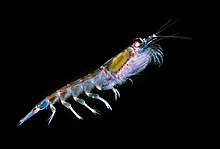
The krill fishery is the commercial fishery of krill, small shrimp-like marine animals that live in the oceans world-wide. The present estimate for the biomass of Antarctic krill (Euphausia superba) is 379 million tonnes.[1] The total global harvest of krill from all fisheries amounts to 150–200,000 tonnes annually, mainly Antarctic krill and North Pacific krill (E. pacifica).
Krill are rich in protein (40% or more of dry weight) and lipids (about 20% in E. superba). Their exoskeleton amounts to some 2% of dry weight of chitin. They also contain traces of a wide array of hydrolytic enzymes such as proteases, carbohydrases, nucleases and phospholipases, which are concentrated in the digestive gland in the cephalothorax of the krill.
Most krill is used as aquaculture feed and fish bait; other uses include livestock or pet foods. Only a small percentage is prepared for human consumption. Their enzymes are interesting for medical applications, an expanding sector since the early 1990s.
- ^ Atkinson, A., Siegel, V., Pakhomov, E.A., Jessopp, M.J., Loeb, V. (2009). A re-appraisal of the total biomass and annual production of Antarctic krill. Deep-Sea Research Part I, 56, 727–740 doi:10.1016/j.dsr.2008.12.007